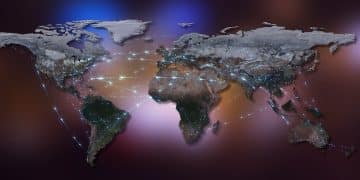Border Security Enhancements: Latest Technologies and Their Effectiveness

Border security enhancements involve the implementation of cutting-edge technologies like AI-powered surveillance, biometric identification, and advanced sensor systems to efficiently monitor and manage borders, aiming to enhance national security and streamline legal crossings, while addressing challenges like cost and privacy concerns.
In an era defined by evolving threats and increasing global mobility, the importance of robust border security cannot be overstated. This article delves into the world of border security enhancements, examining the latest technologies being deployed to safeguard nations and the effectiveness of these innovations.
Border Security: An Evolving Landscape
Border security has transformed significantly over the past few decades, shifting from primarily physical patrols to incorporating a wide array of advanced technologies. This evolution is a response to the increasing complexity of border management, which includes not only preventing illegal crossings but also facilitating legitimate trade and travel.
The need for border security enhancements is driven by factors such as heightened security concerns, growing cross-border crime, and the desire for more efficient border operations. As a result, governments around the world are investing in innovative solutions to strengthen their borders.

Cutting-Edge Technologies in Border Security
The realm of border security is witnessing a technological revolution, with the deployment of advanced systems designed to enhance monitoring, detection, and response capabilities. These technologies are transforming how borders are managed and secured.
Artificial Intelligence and Machine Learning
AI and machine learning are playing a crucial role in analyzing vast amounts of data collected from various sources, such as surveillance cameras and sensors. These technologies can identify patterns and anomalies that might indicate illegal activity.
Biometric Identification Systems
Biometrics, including facial recognition, iris scanning, and fingerprinting, are becoming increasingly common at border crossings. These systems offer a reliable way to verify identities and prevent the use of fraudulent documents.
- Facial Recognition: Automatically identifies individuals by comparing facial features to a database.
- Iris Scanning: Uses unique patterns in the iris to confirm identity with high accuracy.
- Fingerprinting: A well-established biometric method for identity verification.
These technologies offer improved accuracy and speed for identity verification, enhancing both security and efficiency at border crossings.
The Effectiveness of Technology in Border Security
The implementation of technology in border security has yielded varying degrees of success, with effectiveness depending on factors such as the specific technology, the context of its deployment, and the resources available for maintenance and operation.
Analyzing the true effectiveness of these border security enhancements involves considering both their strengths and limitations. While advanced technologies offer significant advantages, they are not without their challenges.
Improved Detection Rates
Advanced surveillance systems and sensors have significantly improved the detection of illicit activities at borders, including drug smuggling, human trafficking, and illegal immigration. These technologies can cover vast areas and operate in diverse weather conditions.
Enhanced Response Times
Real-time data analysis and communication systems enable border patrol agents to respond more quickly and effectively to potential threats. This can help prevent incidents from escalating and improve overall border security.

Challenges and Considerations
Despite the potential benefits, incorporating technology into border security is not without challenges. Factors such as costs, privacy concerns, and the need for ongoing maintenance must be addressed to ensure the successful implementation of these systems.
Balancing security needs with civil liberties and respecting privacy rights is a critical consideration in the deployment of border security enhancements. Failing to do so can erode public trust and create legal challenges.
Cost Implications
The initial investment and ongoing maintenance costs of advanced border security technologies can be substantial. Governments must carefully weigh the costs against the potential benefits to ensure that these investments are sustainable.
Privacy Concerns
The use of surveillance technologies and biometric identification systems raises privacy concerns among civil liberties advocates and the general public. It is essential to implement safeguards to protect personal data and prevent misuse.
- Data Protection: Implementing policies to protect personal information collected by security systems.
- Transparency: Being transparent about the use of technology and its impact on privacy.
- Oversight: Establishing independent oversight mechanisms to monitor the use of technology and ensure compliance with privacy laws.
Addressing privacy concerns is vital for maintaining public support for border security initiatives.
The Future of Border Security Technology
As technology continues to advance, the future of border security is likely to be characterized by even more sophisticated and integrated systems. Artificial intelligence, robotics, and nanotechnology are just a few of the areas that could revolutionize border management.
Continuous innovation and adaptation are crucial for staying ahead of emerging threats and ensuring that border security enhancements remain effective in the long term. This includes investing in research and development and fostering collaboration between government, industry, and academia.
Drone Technology
Drones are increasingly being used for border surveillance, providing aerial views of remote areas and aiding in the detection of illegal activity. Advancements in drone technology are making them more capable and versatile.
Nanotechnology Sensors
Nanotechnology offers the potential for developing highly sensitive and miniature sensors that can detect even trace amounts of illicit substances or explosives. These sensors could be deployed at border crossings and other strategic locations.
Global Perspectives on Border Security Enhancements
Different countries and regions face unique border security challenges and have adopted different strategies to address them. Examining these global perspectives can provide valuable insights into the effectiveness of various approaches.
Understanding how other nations are implementing border security enhancements can inform policy decisions and help identify best practices. This includes learning from both successes and failures.
The European Union
The EU faces the challenge of managing its external borders while facilitating the free movement of people within the Schengen Area. Technology plays a crucial role in this effort, with systems such as the European Border and Coast Guard Agency (Frontex) deploying advanced surveillance and identification tools.
Israel
Israel has invested heavily in border security technologies, including advanced fences and surveillance systems, to protect its borders from threats. These technologies have proven effective in preventing infiltration and attacks.
The Human Element in Border Security
While technology plays an increasingly important role in border security, the human element remains crucial. Border patrol agents, customs officers, and other personnel are essential for interpreting data, making decisions, and responding to threats.
Effective border security enhancements require a strong partnership between technology and human expertise. This includes providing adequate training and support to border personnel and ensuring that technology is used as a tool to enhance their capabilities, not replace them.
| Key Point | Brief Description |
|---|---|
| 🛡️ AI & Machine Learning | Analyzing data for threat detection and anomaly detection. |
| 👤 Biometric Systems | Using facial and iris recognition for identity verification. |
| 🛰️ Drone Technology | Employing drones for aerial surveillance of border areas. |
| 💸 Cost & Privacy | Addressing financial and ethical considerations of tech use. |
Frequently Asked Questions
▼
Key technologies used include AI-powered surveillance, biometric identification, advanced sensors, and drone technology. These systems enhance threat detection, streamline identity verification, and improve overall border monitoring.
▼
Biometric systems like facial recognition and iris scanning are highly effective at verifying identities and preventing document fraud. They provide accurate and rapid identification, improving both security and efficiency at borders.
▼
The main challenges include high costs, privacy concerns, and the need for continuous maintenance and updates. Balancing security needs with civil liberties and ensuring data protection are also critical issues.
▼
Countries can ensure privacy by implementing strict data protection policies, being transparent about technology use, and establishing independent oversight mechanisms. Public education and involvement in policy-making can also build trust.
▼
Despite technological advancements, human expertise remains essential. Border patrol agents and customs officers interpret data, make critical decisions, and respond to threats, ensuring technology enhances rather than replaces their capabilities.
Conclusion
In conclusion, border security enhancements are vital for national security, leveraging advanced technologies to monitor, detect, and respond to evolving threats effectively. While challenges such as costs and privacy concerns exist, ongoing innovation and a strong partnership between technology and human expertise are key to building a secure and efficient border management system.





